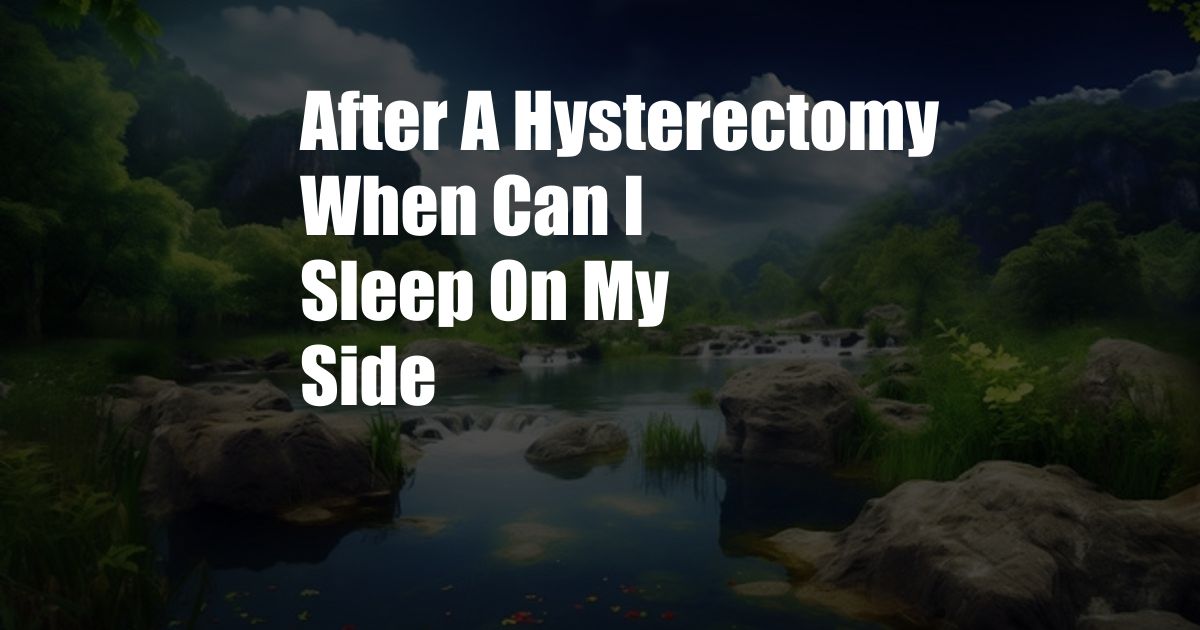
After a Hysterectomy: When Can I Sleep on My Side?
After undergoing a hysterectomy, a surgical procedure involving the removal of the uterus, the recovery process can be physically demanding. Among the concerns that arise post-surgery is the appropriate time to resume sleeping on one’s side. Understanding the healing process after a hysterectomy is crucial to ensure a safe and comfortable recovery.
This article will delve into the intricacies of when it is permissible to sleep on one’s side following a hysterectomy, providing comprehensive insights into the healing timeline and necessary precautions to guarantee a smooth recovery.
The Healing Timeline after a Hysterectomy
Recovery from a hysterectomy typically involves several stages, each characterized by specific physical limitations. In general, the healing timeline can be divided into three phases:
- Weeks 0-6: This initial phase involves significant pain and discomfort, requiring the patient to rest and avoid strenuous activities. Sleeping on one’s side is generally not recommended during this period.
- Weeks 6-12: As the pain subsides, the patient gains strength and mobility. While sleeping on one’s side is still not ideal, it may be tolerated in short intervals with appropriate support.
- Beyond 12 Weeks: Most patients have fully recovered by this stage and can comfortably sleep on their side. However, it is essential to listen to one’s body and avoid any activities that cause pain or discomfort.
Reasons for Avoiding Side Sleeping Early After a Hysterectomy
- Discomfort and Pain: Sleeping on one’s side while the surgical incision is still healing can cause undue pressure and pain.
- Increased Swelling: Side sleeping can impede the natural drainage of fluids, leading to increased swelling and discomfort.
- Risk of Infection: The surgical incision is more vulnerable during the initial healing stages. Sleeping on one’s side can increase the risk of infection by introducing additional pressure to the healing area.
Tips for Sleeping Comfortably After a Hysterectomy
- Sleep on Your Back: Sleeping on one’s back is the most recommended position after a hysterectomy. It minimizes pressure on the incision and promotes proper healing.
- Elevate Your Legs: Elevating your legs while sleeping can help reduce swelling and improve circulation.
- Use Pillows for Support: Place pillows on either side of your body to provide support and prevent rolling onto your side.
- Avoid Heavy Lifting: Avoid lifting heavy objects or engaging in strenuous activities that could strain the incision.
- Listen to Your Body: If you experience any pain or discomfort, stop the activity and seek medical attention.
FAQ
Q: When can I drive after a hysterectomy?
A: Driving is typically not recommended until you can comfortably sit up straight and react quickly without experiencing pain. Consult with your doctor for specific instructions.
Q: What are the signs of infection after a hysterectomy?
A: Symptoms of infection may include fever, chills, pain, redness, or discharge from the incision site. Seek immediate medical attention if you experience any of these.
Q: Can I have sex after a hysterectomy?
A: Most women resume sexual activity 4-6 weeks after a hysterectomy. However, it is crucial to follow your doctor’s instructions and listen to your body.
Q: When should I follow up with my doctor after a hysterectomy?
A: Schedule a follow-up appointment with your doctor 2-4 weeks after the surgery to check on your progress and discuss any concerns.
Conclusion
After a hysterectomy, it is essential to allow your body to heal properly. Sleeping on one’s side should be avoided during the initial recovery phase to minimize discomfort, reduce swelling, and promote optimal healing. By following your doctor’s instructions, listening to your body, and practicing self-care, you will gradually regain your strength and mobility while ensuring a safe and comfortable recovery.
Are you interested in knowing more about the recovery process after a hysterectomy?